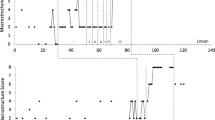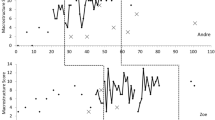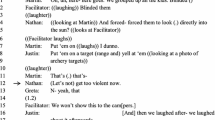Abstract
A multiple probe across participants design was used to examine the effects of intervention on reality-based fictional narratives. Four boys with autism spectrum disorder (ASD) and language disorder, aged 9–10, participated in a 1:1 intervention targeting the narrative macrostructure elements of character, setting, problem, feelings, and fix. Intervention involved clinician modelling, participants saying the entire narrative, narrative stimulus pictures, and macrostructure icons. An intervention effect, maintenance, and generalization to fantasy-based fictional narratives were demonstrated for three participants. Social validity measures indicated that a naive observer-rated post-intervention narratives as better than pre-intervention narratives. This study adds to the limited research into narrative intervention with children with ASD and co-occurring language disorder. The highly structured and semi-scripted intervention could be adapted to be delivered by teachers in small groups in the classroom. Areas for future research include implementing the intervention with small groups and targeting more complex narrative macrostructure.

Similar content being viewed by others
References
Alberto, P. A., & Troutman, A. C. (2017). Applied behavior analysis for teachers: Interactive ninth edition—enhanced Pearson etext (9th ed.). London: Pearson.
Allen, M. S., Kertoy, M. K., Sherblom, J. C., & Pettit, J. M. (1994). Children’s narrative productions: A comparison of personal event and fictional stories. Applied Psycholinguistics, 15(2), 149–176. https://doi.org/10.1017/S0142716400005300.
American Psychiatric Association. (2013). Diagnostic and statistical manual of mental disorders (5th ed.). Author.
Australian Curriculum, Assessment and Reporting Authority [ACARA]. (2016). Australian Curriculum: English. Retrieved October 13, 2017 from https://www.australiancurriculum.edu.au/f-10-curriculum/english/?layout=1#cdcode=ACELA1428&level=F.
Baixauli, I., Colomer, C., Roselló, B., & Miranda, A. (2016). Narratives of children with high-functioning autism spectrum disorder: A meta-analysis. Research in Developmental Disabilities, 59, 234–254. https://doi.org/10.1016/j.ridd.2016.09.007.
Barnes, J. L., & Baron-Cohen, S. (2012). The big picture: storytelling ability in adults with autism spectrum conditions. Journal of Autism and Developmental Disorders, 42(8), 1557–1565. https://doi.org/10.1007/s10803-011-1388-5.
Benson, M. S. (1993). The structure of four-and five-year-olds’ narratives in pretend play and storytelling. First Language, 13(38), 203–223. https://doi.org/10.1177/014272379301303803.
Bishop, D. V. M., & Edmundson, A. (1987). Language-impaired 4-year-olds distinguishing transient from persistent impairment. Journal of Speech and Hearing Disorders, 52(2), 156–173. https://doi.org/10.1044/jshd.5202.156.
Caldwell, D., & White, P. R. R. (2017). That’s not a narrative; this is a narrative: NAPLAN and pedagogies of storytelling. Australian Journal of Language and Literacy, 40(1), 16–27.
National Governors Association Center for Best Practices and Council of Chief State School Officers. (2010). Common core standards. Retrieved October 22, 2018 from http://www.corestandards.org.
Cheshire, J. (2000). The telling or the tale? Narratives and gender in adolescent friendship networks. Journal of Sociolinguistics, 4(2), 234–262. https://doi.org/10.1111/1467-9481.00113.
Department of Education. (2014). National curriculum in England: English programmes of study. Retrieved October 22, 2018 from https://www.gov.uk/government/publications/national-curriculum-in-england-english-programmes-of-study/national-curriculum-in-england-english-programmes-of-study.
Dunn, L. M., & Dunn, D. M. (2007). Peabody picture vocabulary test: fourth edition (PPVT-4) [assessment instrument]. London: Pearson Assessments.
Engel, S. (1995). The stories children tell: Making sense of the narratives of childhood. New York: W.H. Freeman.
Engelmann, S., & Carnine, D. (2016). Theory of instruction: Principles and applications. Eugene: NIFDI Press.
Favot, K., Carter, M., & Stephenson, J. (2018a). The effects of an oral narrative intervention on the fictional narrative retells of children with ASD and severe language impairment: A pilot study. Journal of Developmental and Physical Disabilities, 30(5), 615–637. https://doi.org/10.1007/s10882-018-9608-y.
Favot, K., Carter, M., & Stephenson, J. (2018b). The effects of oral narrative intervention on the personal narratives of children with ASD and severe language impairment: A pilot study. International Journal of Disability, Development and Education, 66(5), 492–509. https://doi.org/10.1080/1034912x.2018.1453049.
Feagans, L., & Appelbaum, M. I. (1986). Validation of language subtypes in learning disabled children. Journal of Educational Psychology, 78(5), 358–364. https://doi.org/10.1037/0022-0663.78.5.358.
Finestack, L. H. (2012). Five principles to consider when providing narrative language intervention to children and adolescents with developmental disabilities. Perspectives on Language Learning and Education, 19(4), 147–154. https://doi.org/10.1044/lle19.4.147.
Gillam, R. B., & Pearson, N. A. (2017). Test of Narrative Language: Second Edition (TNL-2) [Assessment Instrument]. Pro- ed.
Gillam, S. L., Hartzheim, D., Studenka, B., Simonsmeier, V., & Gillam, R. (2015). Narrative intervention for children with autism spectrum disorder (ASD). Journal of Speech Language and Hearing Research, 58(3), 920–933. https://doi.org/10.1044/2015_JSLHR-L-14-0295.
Harrison, P., & Oakland, T. (2015). Adaptive Behavior Assessment System: Third Edition (ABAS-III) [Assessment Instrument]. Western Psychological Services.
Hedberg, N. L., & Westby, C. E. (1993). Analyzing storytelling skills: Theory to practice. The Psychological Corporation.
Horner, R. D., & Baer, D. M. (1978). Multiple-probe technique: A variation of the multiple baseline. Journal of Applied Behavior Analysis, 11(1), 189–196. https://doi.org/10.1901/jaba.1978.11-189.
Hudson, J., & Shapiro, L. (1991). From knowing to telling: The development of children’s scripts, stories and personal narrative. In A. McCabe & C. Peterson (Eds.), Developing narrative structure (pp. 89–136). Mahwah: Erlbaum.
Hughes, D. L., McGillivray, L., & Schmidek, M. (1997). Guide to narrative language: Procedures for assessment. Washington: Thinking Publications.
Johnston, J. R. (2008). Narratives: Twenty-five years later. Topics in Language Disorders, 28(2), 93–98. https://doi.org/10.1097/01.TLD.0000318931.08807.01.
Justice, L. M., Bowles, R. P., Kaderavek, J. N., Ukrainetz, T. A., Eisenberg, S. L., & Gillam, R. B. (2006). The index of narrative microstructure: A clinical tool for analyzing school-age children’s narrative performances. American Journal of Speech-Language Pathology, 15(2), 177–191.
Kaderavek, J. (2015). Language disorders in children: Fundamental concepts of assessment and intervention (2nd ed.). London: Pearson.
King, D., Dockrell, J., & Stuart, M. (2014). Constructing fictional stories: A study of story narratives by children with autistic spectrum disorder. Research in Developmental Disabilities, 35(10), 2438–2449. https://doi.org/10.1016/j.ridd.2014.06.015.
Layne, C. M. (2007). Early identification of autism: Implications for counselors. Journal of Counseling and Development, 85(1), 110–114. https://doi.org/10.1002/j.1556-6678.2007.tb00452.x.
Lindgren, S., & Doobay, A. (2011). Evidence based interventions for autism spectrum disorders. University of Iowa. http://www.interventionsunlimited.com/editoruploads/files/Iowa%20DHS%20Autism%20Interventions%206-10-11.pdf.
Losh, M., & Capps, L. (2003). Narrative ability in high-functioning children with autism or Asperger’s syndrome. Journal of Autism and Developmental Disorders, 33(3), 239–251. https://doi.org/10.1023/A:1024446215446.
Loveland, K., & Tunali, B. (1993). Narrative language in autism and the theory of mind hypothesis: A wider perspective. In S. BaronCohen, H. Tager-Flusberg, & D. Cohen (Eds.), Understanding other minds: Perspectives from autism (pp. 247–266). Oxford: Oxford University Press.
Mayer, M. (1987). There’s an alligator under my bed. New York: Penguin.
Mayer-Johnson. (2008). Boardmaker (Version 6) [Computer software]. Mayer-Johnson.
McCabe, A. (1991). Preface: Structure as a way of understanding. In A. McCabe & C. Peterson (Eds.), Developing narrative structure (pp. X–XVII). New York: Lawrence Erlbaum Associates.
McCabe, A., Bliss, L., Barra, G., & Bennett, M. (2008). Comparison of personal versus fictional narratives of children with language impairment. American Journal of Speech-Language Pathology, 17(2), 194–206. https://doi.org/10.1044/1058-0360(2008/019).
Morrow, L. M. (1985). Retelling stories: A strategy for improving young children’s comprehension, concept of story structure, and oral language complexity. The Elementary School Journal, 85(5), 647–661. https://doi.org/10.1086/461427.
Norbury, C. F., & Bishop, D. V. (2003). Narrative skills of children with communication impairments. International Journal of Language and Communication Disorders, 38(3), 287–313. https://doi.org/10.1080/136820310000108133.
Owens, R. E. (2016). Language development: An introduction (9th ed.). London: Pearson.
Paley, V. G. (1990). The boy who would be a helicopter. Cambridge: Harvard University Press.
Petersen, D. B. (2011). A systematic review of narrative-based language intervention with children who have language impairment. Communication Disorders Quarterly, 32(4), 207–220. https://doi.org/10.1177/1525740109353937.
Petersen, D. B., Brown, C. L., Ukrainetz, T. A., Wise, C., Spencer, T. D., & Zebre, J. (2014). Systematic individualized narrative language intervention on the personal narratives of children with autism. Language, Speech, and Hearing Services in Schools, 45(1), 67–86. https://doi.org/10.1044/2013_LSHSS-12-0099.
Petersen, D. B., Gillam, S. L., Spencer, T., & Gillam, R. B. (2010). The effects of literate narrative intervention on children with neurologically based language impairments: An early stage study. Journal of Speech, Language, and Hearing Research, 53(4), 961–981. https://doi.org/10.1044/1092-4388(2009/09-0001).
Random.org. (n.d.). True random number generator. Retrieved 5 September, 2017 from https://www.random.org.
Rapoff, M., & Stark, L. (2008). Editorial: Journal of Pediatric Psychology statement of purpose: Section on single-subject studies. Journal of Pediatric Psychology, 33(1), 16–21. https://doi.org/10.1093/jpepsy/jsm101.
Reese, E., & Newcombe, R. (2007). Training mothers in elaborative reminiscing enhances children’s autobiographical memory and narrative. Child Development, 78(4), 1153–1170. https://doi.org/10.1111/j.1467-8624.2007.01058.x.
Roid, G. (2003). Stanford-Binet Intelligence Scales: Fifth Edition (SB-5) [Assessment Instrument]. Riverside Publishing.
Rollins, P. (2014). Personal narratives in individuals with high-functioning ASD: A lens Into social skills. SIG 1 Perspectives on Language Learning and Education. https://doi.org/10.1044/lle21.1.13
Schopler, E., Van Bourgondien, M. E., & Love, S. R. (2010). Childhood autism rating scale, second edition (CARS-2) [assessment instrument]. Torrance: Western Psychological Services.
Semel, E. M., Wiig, E. H., & Secord, W. (2003). Clinical evaluation of language fundamentals: fourth edition [assessment instrument]. New York: The Psychological Corporation.
Spencer, T. D., Kajian, M., Petersen, D. B., & Bilyk, N. (2013). Effects of an individualized narrative intervention on children’s storytelling and comprehension skills. Journal of Early Intervention, 35(3), 243–269. https://doi.org/10.1177/1053815114540002.
Spencer, T. D., & Petersen, D. B. (2018). Bridging oral and written language: An oral narrative language intervention study with writing outcomes. Language Speech and Hearing Services in Schools, 49(3), 1. https://doi.org/10.1044/2018_lshss-17-0030.
Spencer, T. D., Weddle, S. A., Petersen, D. B., & Adams, J. L. (2017). Multi-tiered narrative intervention for preschoolers: A Head Start implementation study. NHSA Dialog, 20(1), 1–28.
Sperry, L. L., & Sperry, D. E. (1996). Early development of narrative skills. Cognitive Development, 11(3), 443–465. https://doi.org/10.1016/S0885-2014(96)90013-1.
Stein, N. L., & Glenn, C. G. (1978). An analysis of story comprehension in elementary school children. In R. O. Freedle (Ed.), New directions in discourse processing (pp. 53–120). Norwood: Ablex Publishing Corporation.
Stirling, L., Douglas, S., Leekam, S., Carey, L., Arciuli, J., & Brock, J. (2014). The use of narrative in studying communication in autism spectrum disorders. In Communication in autism, trends in langauge acquistion research (pp. 169–216). John Benjamins Publishing Company. http://books.google.com/books?hl=en&lr=&id=K_XEBAAAQBAJ&oi=fnd&pg=PA171&dq=the+use+of+narrative+Stirling&ots=Otrqi8ldfs&sig=nMbr6U-nySq6cLTGf0eHjGZ9aS8.
Wechsler, D. (2016). Wechsler Intelligence Scales for Children: Fifth Edition, Australian and New Zealand Standardised Edition (WISC-V A&NZ) [Assessment Instrument]. Pearson Clnical Assessment.
Westby, C. (1991). In C. S. Simon (Ed.), Communication skills and classroom success (pp. 334–357). Washington: Thinking Publications.
Westerveld, M. F., & Gillon, G. T. (2010). Oral narrative context effects on poor readers’ spoken language performance: Story retelling, story generation, and personal narratives. International Journal of Speech-Language Pathology, 12(2), 132–141. https://doi.org/10.3109/17549500903414440.
Wiig, E. H., Secord, W. A., & Semel, E. (2017). Clinical evaluation of language fundamentals: Fifth edition, Australian and New Zealand Standardised Edition (CELF-5 A&NZ) [assessment instrument]. Pearson Clinical Assessment.
Funding
No grants or any other financial support was received for this paper.
Author information
Authors and Affiliations
Corresponding author
Ethics declarations
Conflict of interest
The authors declare that they have no conflict of interest.
Ethical Approval
All procedures performed in studies involving human participants were in accordance with the ethical standards of the institutional and / national research committee and with the 1964 Helsinki declaration and its later amendments of comparable ethical standards.
Informed Consent
Informed consent was obtained from parents of all individual participants included in the study.
Additional information
Publisher's Note
Springer Nature remains neutral with regard to jurisdictional claims in published maps and institutional affiliations.
Appendix 1
Appendix 1
Macrostructure element | 2 points | 1 point | 0 |
|---|---|---|---|
Scorer should not need shared knowledge to understand the information | Key words or phrases, but not specific or clear, may be attributed to the wrong person | No information or incorrect information | |
Character | Main character’s name | Broad character description (e.g. the boy, the brother) | Pronouns, someone |
Setting | Activity and the location (e.g. eating pizza in the kitchen), “home” acceptable if story makes sense | Activity or location (e.g. say “home” or “eating pizza”) | No information or incorrect information |
Problem | Statement of what went wrong in the story | Incomplete, not clear, uses vague vocabulary | No information or incorrect information |
Feelings about the problem | Specific appropriate emotion | Emotion named but may be inappropriate, or general behaviour related to the problem (e.g. “didn’t like it) | No information or incorrect information |
Fix | Specific information that states what characters (main or secondary) did to fix the problem, can use dialogue or description, may assume the voice of the character | Broad description of what was done (e.g. asked for help, X helped Y), correct actions but attributed to the wrong people or it’s unclear | No information or incorrect information |
Rights and permissions
About this article
Cite this article
Favot, K., Carter, M. & Stephenson, J. The Effects of an Oral Narrative Intervention on the Fictional Narratives of Children with Autism Spectrum Disorder and Language Disorder. J Behav Educ 31, 657–678 (2022). https://doi.org/10.1007/s10864-021-09430-9
Accepted:
Published:
Issue Date:
DOI: https://doi.org/10.1007/s10864-021-09430-9




